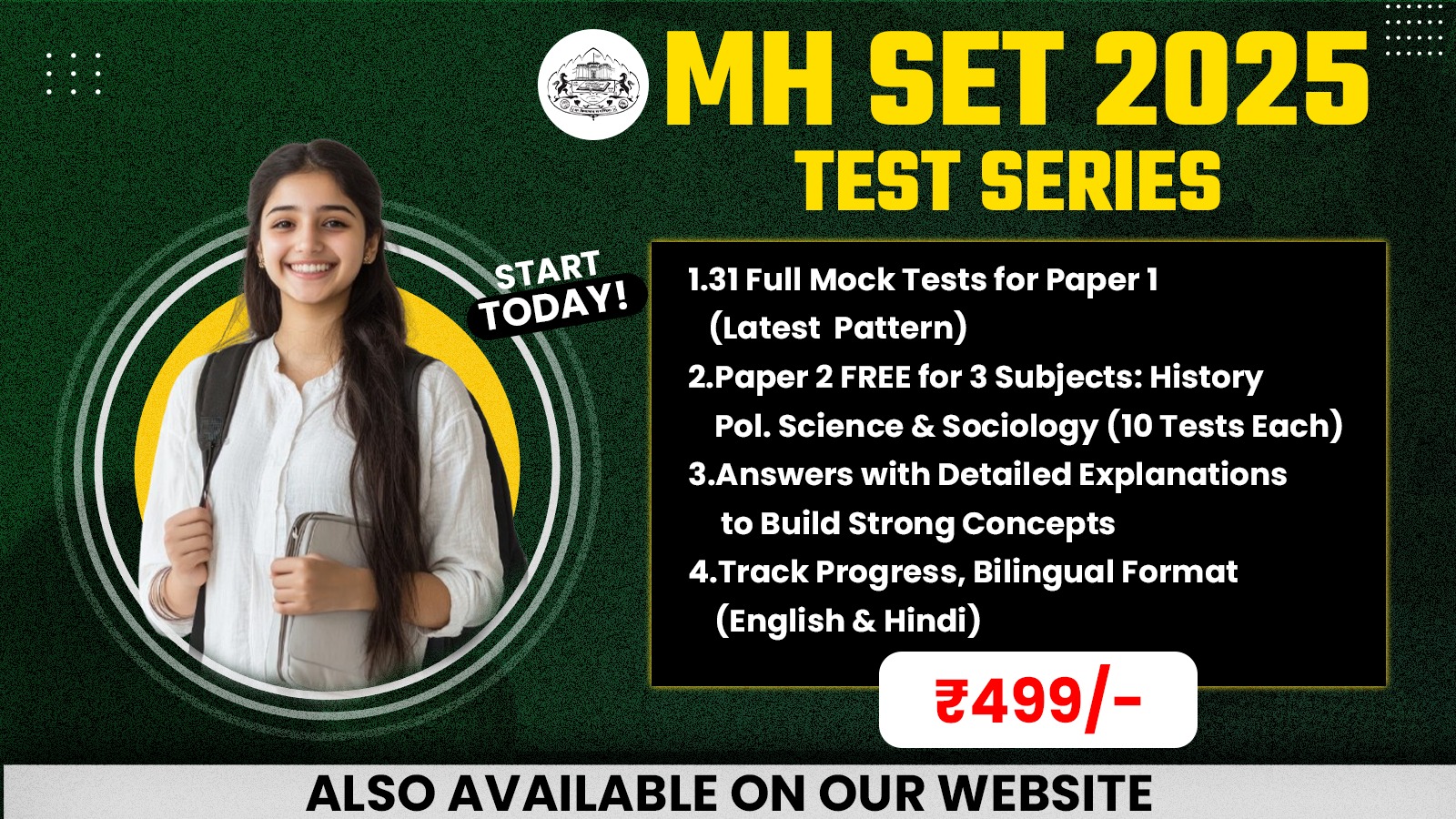India's Structured Online Test series platform
Boost your exam preparation with test series for UGC NET, SET Exam, TET exam and major Teaching exam.
Boost your exam preparation with test series for UGC NET, SET Exam, TET exam and major Teaching exam.

MHSET Test Series 2025 by JRFAdda is one of the most helpful test series for candidates preparing for the Maharashtra State Eligibility Test (MHSET). It is designed to match the latest MHSET exam pattern and syllabus. Practicing with the MHSET mock test series online, previous year papers, and subject-wise practice questions can certainly help candidates improve their speed, accuracy, and confidence. Whether you are attempting the exam for the first time or looking to improve your score, a good MHSET mock test series online is the best way to prepare for the MHSET exam.

Your one-stop hub of learning materials designed to simplify concepts and boost exam preparation.
Prepare for the level expected in the upcoming exams.
Save important Tests & Questions to revise or reattempt them later.

Get insights on your Strengths & Weaknesses, All India Rank & Performance Comparison with the Topper

The MHSET Test Series 2025 is designed to provide aspirants with a structured, exam-oriented practice platform. Based on the Maharashtra State Eligibility Test (MHSET) exam pattern and previous year trends, this test series ensures comprehensive preparation, performance analysis, and confidence building before the final exam. It simulates the actual exam environment and helps aspirants strengthen their concepts, time management, and accuracy.
The MHSET (Maharashtra State Eligibility Test) is conducted to determine the eligibility of candidates for the post of Assistant Professor in universities and colleges across Maharashtra. Preparing for such a competitive exam requires a systematic approach, regular practice, and exposure to exam-like conditions.
The MHSET Test Series 2025 is curated by subject experts after thorough research and analysis of previous year question papers (PYQs), ensuring maximum relevance. The tests are designed to cover all sections of the syllabus while helping aspirants build confidence and evaluate their preparation level.
✅ 31 Full Mock Tests for Paper 1 (Latest UGC Pattern)
✅ Free Paper 2 Tests for History, Political Science & Sociology (10 Tests Each)
✅ Detailed Explanations for every answer to strengthen concepts
✅ Track Your Progress with advanced performance analysis
✅ Bilingual Format – Available in both English & Hindi
✅ Real Exam Simulation to boost confidence
✅ Covers Complete MHSET Syllabus systematically
✅ Designed by Experts based on latest trends & PYQs
✅ Affordable Pricing – Only ₹499/- for full access
✅ Available Exclusively Online for easy access
✅ Time Management Practice with full-length tests
✅ Chapter-Wise Practice via Paper 2
✅ Nationwide Rank Comparison with other aspirants
✅ Build Exam Temperament with multiple practice rounds
✅ Self-Evaluation Reports after every test
✅ Focus on Conceptual Clarity with detailed solutions
✅ Flexible Learning – attempt anytime, anywhere
✅ Improves Speed & Accuracy through repeated practice
✅ High-Quality Question Bank curated by subject experts
✅ Boosts Exam Readiness with structured preparation
The MHSET is a state-level exam and is conducted by the Savitribai Phule Pune University (SPPU). Here is the complete overview of the MHSET exam mentioned in the table:
|
Particulars |
Details |
|
Exam Name |
Maharashtra State Eligibility Test (MHSET) |
|
Conducting Body |
Savitribai Phule Pune University (SPPU) |
|
Level |
State-level |
|
Frequency |
Once a year |
|
Purpose |
Eligibility for Assistant Professor |
|
Mode of Exam |
Offline (OMR-based) |
|
Exam Duration |
3 hours (Paper I: 1 hr, Paper II: 2 hrs) |
|
Official Website |
Also Read: MHSET Exam 2025 Eligibility
MHSET Exam Pattern and Syllabus provide candidates with a clear understanding of the MHSET exam and help them to prepare effectively. Knowing the structure of Paper 1 and Paper 2, and the detailed syllabus, is essential for the candidates to prepare for the MHSET exam along with the MHSET Test Series 2025.
It is important for the candidates to have a complete knowledge of the MHSET Exam Pattern 2025 before starting the preparation. The MHSET exam is divided into two papers- Paper 1 (common for all) and Paper 2 (subject-specific). Both papers are conducted offline on the same day, with no negative marking.
|
Features |
Paper 1 |
Paper 2 |
|
Total Questions |
50 Questions |
100 Questions |
|
Total Marks |
100Marks |
200 Marks |
|
Total Duration |
1 Hour |
2 Hours |
|
Question Type |
MCQs |
MCQs |
|
Negative Marking |
No negative marking |
No negative marking |
Also Read: MHSET Exam Pattern 2025
By understanding the MHSET syllabus, the aspirants can plan their studies, focus on important topics, and practice with the right strategy for success in the MHSET examination.
Paper 1: Based on the teaching aptitude, reasoning, communication, ICT, and general awareness.
Paper 2: Based on the candidate’s chosen subject.
Also Read: MHSET Syllabus 2025 for Paper 1 & 2
How to Crack the MHSET Exam 2025
A well-planned MHSET Test Series 2025 not only boosts your confidence but also improves your chances of clearing the MHSET exam on your first try. Here is how you can prepare using the MHSET Test Series 2025 to crack the MHSET Exam:
Know the Syllabus: Understand the full MH SET exam pattern and syllabus before starting your preparation.
Create a Timetable: Divide your study time between Paper 1 and Paper 2. Tackle your weaker sections first.
Take Regular Tests: Attempt multiple MHSET coaching test series to build speed and accuracy on a regular basis.
Analyze Your Performance: After every test from the MHSET Test Series, analyze your performance and review solutions to identify weak areas.
Revise Frequently: Revise on a regular basis and keep revising important topics to retain key concepts.
Also Read: MHSET Preparation Strategy 2025
Regular practice using the MHSET Test Series 2025 is the key to success in MHSET. Use MH SET practice questions with solutions and MHSET sample question paper PDF, all provided in the MHSET Test Series, to test your knowledge after completing each topic. Below are some of the main benefits of using the MHSET Test Series 2025:
Improve Speed: Using the MHSET Test Series can build speed and accuracy for solving 150 questions in a limited time.
Analyze your Preparation: The JRFAdda’s MHSET Test Series 2025 helps track your progress with performance analysis.
Practice Mock Papers and Questions: The test series provides MHSET practice questions with solutions for detailed understanding.
Build Confidence: Using the PHSET Test Series can improve confidence for the actual exam day.
Also Read: MHSET Previous Year Question Papers
The MHSET Test Series 2025 is one of the best tools for candidates to prepare for the upcoming MHSET examination. Along with the mock tests, the aspirants can also solve the MHSET sample question paper PDF for extra preparation. By combining the previous year's question papers with the full-length and subject-wise mock tests, the candidates can get a better coverage of the syllabus.
You can easily enroll by visiting our official website, selecting the Test Series package of your choice, and completing the payment. After enrollment, instant access will be provided.
The pricing depends on the specific exam category and package. We aim to keep our plans affordable for all aspirants while providing maximum value.
Our Test Series is designed to simulate real exam conditions, provide in-depth explanations, and deliver detailed performance analysis. This ensures better time management, improved accuracy, and enhanced confidence.
Most of our test series are available in English and Hindi. For some exams, additional regional language options may also be provided.
Yes, you can attempt the tests as many times as you want. Re-attempting helps in learning from mistakes and building strong conceptual clarity.
Yes. Every test comes with comprehensive performance reports – including subject-wise, topic-wise, and overall analysis – so you can track your progress effectively.
Yes, the Test Series is conducted exclusively online so that you can attempt tests anytime, anywhere at your convenience.
All questions are prepared by experienced subject experts after thorough research and analysis of previous year papers and latest exam trends.
